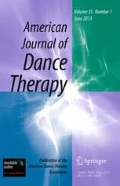Abstract
Creativity, at times, flows freely amongst individuals. However, at other times, creativity waivers on the edge of meaning and nothingness. This manuscript explores Eastern and Western philosophies associated with void, the thin line between dialectical phenomena, and a space which opens up for creativity. These theories of creativity will be observed through a dance/movement therapy (DMT) paradigm examining the concept of stillness within movement and particularly within a DMT session. A brief review of the following phenomena will be considered: the fertile void, the dialectical edge, and potential space. Consideration will be given to the notion of stillness as a tool for creativity in DMT and supported by case vignettes.
Similar content being viewed by others
References
Caldwell, C. (2004). The power of stillness, the glory of motion. American Journal of Dance Therapy, 26, 9–15.
Franken, R. E. (1998). Human motivation. Pacific Grove, CA: Brooks/Cole.
Hagman, G. (2005). Aesthetic experience: Beauty, creativity, and the search for the ideal. New York: Rodopi.
Harris, D. A. (2007). Pathways to embodied empathy and reconciliation after atrocity: Former boy soldiers in a dance/movement therapy group in Sierra Leone. Intervention, 5(3), 203–231.
Homann, K. B. (2010). Embodied concepts of neurobiology in dance/movement therapy practice. American Journal of Dance Therapy, 32, 80–99. https://doi.org/10.1007/s10465-010-9099-6.
Israelstam, K. (2007). Creativity and dialectical phenomena. International Journal of Psychoanalysis, 88, 591–607.
Lear, J. (2005). Freud. New York: Routledge.
Ogden, T. H. (1992). Potential space. The matrix of the mind: Object relations and the psychoanalytic dialogue (pp. 203–232). London: Karnac.
Ogden, T. H. (2004). On holding and containing, being and dreaming. International Journal of Psychoanalysis, 85, 1349–1364.
Ricour, P. (1970). Freud philosophy: An essay on interpretation. New Haven, CT: Yale University Press.
Runco, M. A., & Jaeger, G. J. (2012). The standard definition of creativity. Creativity Research Journal, 24(1), 92–96. https://doi.org/10.1080/10400419.2012.650092.
Schmidt, N. B., Richey, J. A., Zvolensky, M. J., & Maner, J. K. (2009). Exploring human freeze responses to a threat stressor. Journal of Behavioral Therapy and Experimental Psychiatry, 39(3), 292–304. https://doi.org/10.1016/j.jbtep.2007.08.002.
Tzu, L. (1891). Tao Te Ching. In Sacred Books of the East (Vol. 39) (J. Legge, Trans.). Oxford: The Clarendon Press.
Van Dusen, W. (1958). Wu wei. No-mind and the fertile void in psychotherapy. In A. Molino (Ed.), The Couch and the tree (pp. 52–57). New York: North Point Press.
Winnicott, D. W. (1953). Transitional objects and transitional phenomena: A study of the first not-me possession. The International Journal of Psychoanalysis, 34, 89–97.
Author information
Authors and Affiliations
Corresponding author
Ethics declarations
Conflict of interest
This author has no potential conflict of interest pertaining to this submission to American Journal of Dance Therapy.
Ethical Approval
This article does not contain any studies with human participants performed by the author.
Additional information
Publisher's Note
Springer Nature remains neutral with regard to jurisdictional claims in published maps and institutional affiliations.
Rights and permissions
About this article
Cite this article
Biondo, J. Stillness in Dance/Movement Therapy: Potentiating Creativity on the Edge and in the Void. Am J Dance Ther 41, 113–121 (2019). https://doi.org/10.1007/s10465-018-9291-7
Published:
Issue Date:
DOI: https://doi.org/10.1007/s10465-018-9291-7




